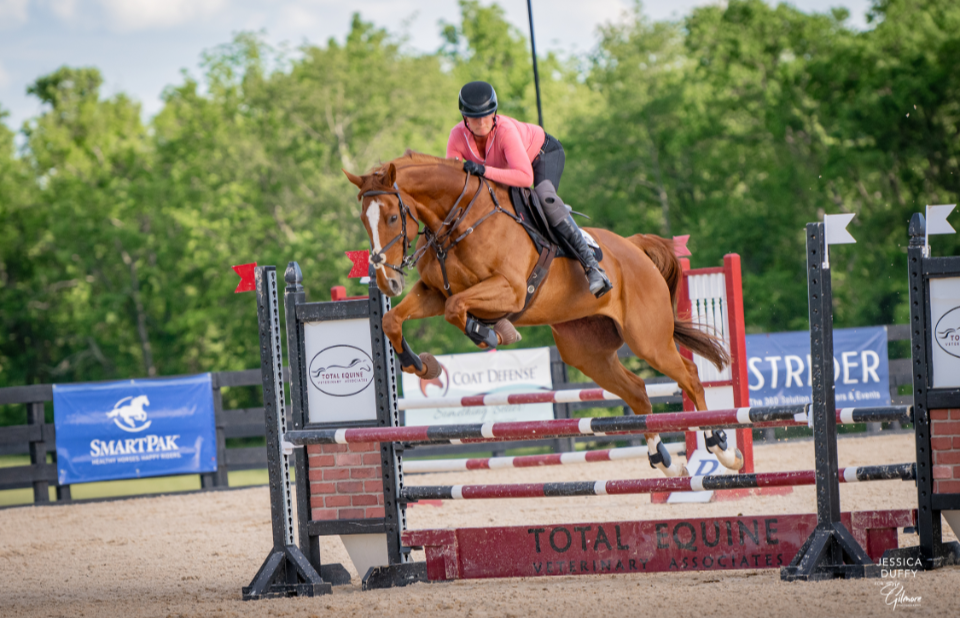Elkton, Md. – The 2022 MARS Maryland 5 Star at Fair Hill presented by Brown Advisory came to an exciting conclusion with Sunday’s show jumping phase. Combinations rode over solid tracks designed by Ken Krome (USA) to determine the final placings in the CCI3*-L and CCI5*-L divisions. Elisa Wallace and Renkum Corsair rose to the occasion to win the 2022 USEF CCI3*-L Eventing National Championship for the USEF Combined Training Trophy.
USEF CCI3*-L Eventing National Championship
Wallace (Reddick, Fla.) and Renkum Corsair climbed to the top of the USEF CCI3*-L Eventing National Championship leaderboard with strong performances in each of the three phases. The pair started on a dressage score of 26.4 and added nothing to their score in the cross-country phase. Wallace and the Corsair Syndicate, LLC’s 2010 Holsteiner gelding closed out the competition on a high note with a double-clear show jumping round to clinch the win on their dressage score.
With several combinations having rails over the show jumping track throughout the morning, Wallace was aware of challenges posed by the tight course in the electric atmosphere. She took confidence in Renkum Corsair’s show jumping background, which included 1.45-meter classes as a seven-year-old.
“I just pretended it was a jumper round at [the World Equestrian Center],” said Wallace. “He felt fantastic. He didn’t feel affected at all by the day before. He jumped a beautiful round, and it was quite fun to be in there. I was really ecstatic, and I couldn’t be more appreciative of my owners in the syndicate. The horse is just a really cool horse.”
The result is made more meaningful after Wallace lost her top mount, Riot Gear, to a pasture accident about a year ago. With the help of her owners, Wallace was able to regroup and look for another partner. Renkum Corsair was the horse that they found, and his and Wallace’s partnership is turning into something special.
“Renkum Corsair, or ‘Caz,’ reminds me a lot of [Riot Gear]. Just to think of this year and how I found the connection with him, I brought him over [from Europe], and it didn’t go super great in the beginning,” said Wallace of Caz. “I feel like there’s a lot more to come for him. He is just getting stronger and stronger [in dressage], then on cross-country he was a little machine out there. Even when we had the hold, he stayed relaxed and with me. He answered all the questions and had a really big heart out there. Today, he just felt at home in that ring and really gave me the confidence that I have been struggling to find, so it really means a lot.”
Jenny Caras (Buckhead, Ga.) and Sommersby climbed from 14th to the Reserve Champion spot by finishing on their dressage score of 29.9 after two double-clear jumping rounds. Caras hoped that she could finish in the top five with her and Jerry Hollis’s 2012 Holsteiner gelding, but their results exceeded her expectations.
“I just knew that I needed to go in and jump my round. My horse had every capability of jumping a clear round so I just needed to not do anything silly. That was all I could do,” said Caras. “I came to this event wanting to finish on my dressage score. That was my goal; getting as low of a score in the first phase as I could and then finish on it. We have done that now and I couldn’t be more proud of him.”
Cassie Sanger (Lakeville, Conn.) and Fernhill Zoro delivered impressive rides throughout the competition to finish third overall and win the USEF CCI3*-L Young Rider Eventing National Championship for the John H. Fritz Trophy as the highest-placed young rider combination. Sanger and Nina Sanger’s 2008 Irish Sport Horse gelding had a dressage score of 26.6, a double-clear cross-county round, and one rail down in the show jumping phase to end on a score of 30.6.
Though the CCI3*-L at MARS Maryland 5 Star at Fair Hill presented by Brown Advisory seemed like a pipedream while she was making her plans at the beginning of the season, Sanger put in the work and made the dream a reality.
“We kept ticking along and solidifying my partnerships with both of my horses, and they couldn’t have been better,” said Sanger. “Riding is a hard sport. There are things that I already wish I could’ve done better and I’m already thinking about improving upon, but it is exciting to be here.”
Alexander O’Neal (Reddick, Fla.) and Redtail Penumbra were the highest-placed young horse combination to win the USEF CCI3*-L Young Horse Eventing National Championship for the Jonathan R. Burton Trophy. O’Neal and Elinor MacPhail O’Neal’s 2015 Westphalian mare started off in 26th place with their dressage score of 32.5 and two double-clear jumping rounds helped them climb to finish seventh overall.
MARS Maryland 5 Star: [Website] [Results]


































